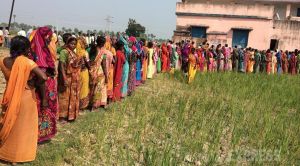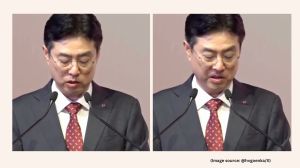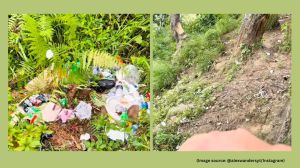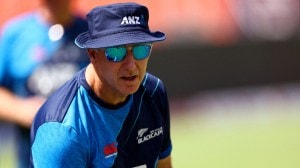Ritika Chopra, an award-winning journalist with over 17 years of experience, serves as the Chief of the National Bureau (Govt) and National Education Editor at The Indian Express in New Delhi. In her current role, she oversees the newspaper's coverage of government policies and education. Ritika closely tracks the Union Government, focusing on the politically sensitive Election Commission of India and the Education Ministry, and has authored investigative stories that have prompted government responses. Ritika joined The Indian Express in 2015. Previously, she was part of the political bureau at The Economic Times, India’s largest financial daily. Her journalism career began in Kolkata, her birthplace, with the Hindustan Times in 2006 as an intern, before moving to Delhi in 2007. Since then, she has been reporting from the capital on politics, education, social sectors, and the Election Commission of India. ... Read More
Transform, teacher by teacher
To mark Teacher’s Day next Monday, The Indian Express tracks down national award-winning teachers from last year and from this year’s shortlist to find that education reform is being powered more by individual teachers innovating in small ways rather than the institution
 Lukhimai Ranee wants to prevent dropouts among girl students, equip them for jobs in Ri-Bhoi, Meghalaya. Dasarath Deka
Lukhimai Ranee wants to prevent dropouts among girl students, equip them for jobs in Ri-Bhoi, Meghalaya. Dasarath Deka
TWO years ago, a powerful Teacher’s Day postcard could have been a photo of 500 students protesting in Bhim, a small dusty town in Rajasthan. The students, all girls, marched down the street carrying posters and shouting slogans. Their demand was simple — ‘700 students, 3 teachers; fill up the vacancies now’. Today, with eight teachers for 700 students, things have hardly improved — there are still no subject-specific teachers in senior classes.
Nationally, government schools are battling an acute shortage of teachers, with over 1 lakh running only on a single teacher, according to figures compiled by the National University of Educational Planning and Administration.
And yet, there are success stories. According to a UNESCO report released last year, the share of out-of-school children has dropped by 90 per cent since 2000 and almost all schools have an equal ratio of boys and girls at the primary and secondary levels. There are a total of 14 lakh schools across the country with 98 per cent of habitations having a primary school (class I-V) within one kilometre and 92 per cent having an upper primary school (class VI-VIII) within a three-kilometre radius.

But keeping students in school through graduation is still a problem. Nationally, almost half of the children that enrolled in Class I, drop out before completing Class X. Quality of learning is another challenge. According to Pratham’s Annual Status of Education (ASER) 2014 report, 48.1 per cent children in Class V could read a Class II textbook — every second Class V student in rural India can’t read Class II text.
Which brings the problem back to the predicament which forced school kids in Rajasthan to take to the streets. There aren’t enough teachers, there aren’t enough quality teachers to improve learning outcomes.
So while considerable energy has gone into improving education through the landmark Sarva Shiksha Abhiyan (SSA), mission-mode efforts are no longer enough to bring lasting reform unless systemic changes are brought about in teacher recruitment and education. Recently, the Delhi government was in the news for its plans to send 200 government school principals abroad and another 200 to different IIMs for training. But such efforts are few.
The Indian Express tracks down teachers who won the National Awards last year and are on the shortlist for this year and finds out that innovation in improving learning outcomes is still largely personal — by teachers operating as changemakers.
Winners, 2015
Lukhimai Ranee
School: Ri-Bhoi Presbyterian Senior Secondary School, Nongpoh, Meghalaya
Experience: 28 years
ROLE: Teaches English, Moral Science, Social Studies, Health Education for classes III-VIII. Looks after Bharat Scouts and Guides activities of Ri-Bhoi district.
GOAL IN 2015: Empower girl students, prevent dropouts
WHAT EXPRESS FOUND: The school has 431 girls against 497 boys, with girls outnumbering boys in nine of the 13 classes. Last year, only two girls dropped out as against five the previous year. Ensured that more girls join scouts and guides activities. Added 11 schools to the scouts and guides programme, with five students, including three girls, from district getting the Governor’s award. “I have tried to raise the confidence level of girls, and make them smarter and more eligible for employment,” says Ranee.
Makhan Singh
School: Talwandi Aklia Middle School, Mansa, Punjab
Experience: 23 years
ROLE: Mainly teaches Punjabi from class VI-VIII, and arts and crafts. Also teaches Maths and English in case of staff shortage.
GOAL IN 2015: Ensure that all children in the village attend school, create awareness against drug addiction
WHAT EXPRESS FOUND: Almost doubled enrollment in Class VI, from 19 to 32. Ensured zero dropouts from Class VIII to IX, mostly children of daily wage labourers, often by visiting their homes to convince parents. Took out rallies of students to create awareness against drug abuse, on environment conservation, mainly stubble-burning in fields leading to at least a 50 per cent cut in the practice. “Apart from studies, I am trying to impart values to students,” he says.
Sanjay Ramdas Sonawane
School: Mahatma Gandhi Shikshan Mandal Sanchalit Madhyamik School, Jalgaon, Maharashtra
Experience: 20 years
Role: Teaches Maths and Science
goal in 2015: Utilise municipal and state government schemes for students
WHAT EXPRESS FOUND: Opened zero balance bank accounts for students of backward classes to ensure that scholarships are directly transferred to them instead of schools. Wrote articles in newspapers — he doubles up as a journalist — to improve student-teacher ratio in tribal hamlets in the Satpuda range near Jalgaon, which is currently two teachers for classes I-IV. The state government has recently started an initiative to improve the ratio for such schools. Initiated remedial classes for students of Class IX. “As compared to 80 per cent overall pass percentage, our school has been scoring 100 per cent pass percentage over the last two years,” says Sonawane.
Winners, 2016
Anwar Jahan
School: Government Girls Inter College, Azamgarh
Experience: 32 years
ROLE: Teaches English, is principal of the inter-college.
GOAL FOR 2016: Change lives of her girl students, most of whom come from poor families in eastern Uttar Pradesh.
WHAT EXPRESS FOUND: Lifted the overall result of her school to between 80-100 per cent. Her school, for the first time, achieved 92 per cent result in this year’s UP secondary board exam. Organises extra classes, arranged for a computer tutor, both on her own initiative. Started organising annual days to motivate talented students — one of them is now a DySP and another cleared the judicial examinations. “Recently, one of my students, whose father is a labourer and mother a tailor, applied for a BSc course in Aligarh Muslim University and got through. This is my motivation,” says Jahan.
Prakashkumar Batukray Dave
School: Galkotdi Prathmik Shala, Amreli, Gujarat
Experience: 24 years
ROLE: Teaches Gujarati for classes VI-VIII. Member of experts panel of Gujarat Council of Educational Research and Training (GCERT) and state’s action research core committee that looks at learning issues in schools.
GOAL FOR 2016: School education for children from poor families
WHAT EXPRESS FOUND: Actively ensured enrolment of at least 800 students over the last two decades in the same school, reaching 100 per cent primary school enrolment in village with population of nearly 2,000. Introduced the concept of daily parent-teacher meetings. A poem penned by him, ‘Sainik Sainik Ramiye’ is a part of Class IV Gujarati curriculum. “As a child, I have seen my father, who was also a teacher, work in different villages for the upliftment of poor. Since then, I decided to work for this section of the society. Poor rural parents are not aware about value of education,” says Dave.



- 01
- 02
- 03
- 04
- 05





























